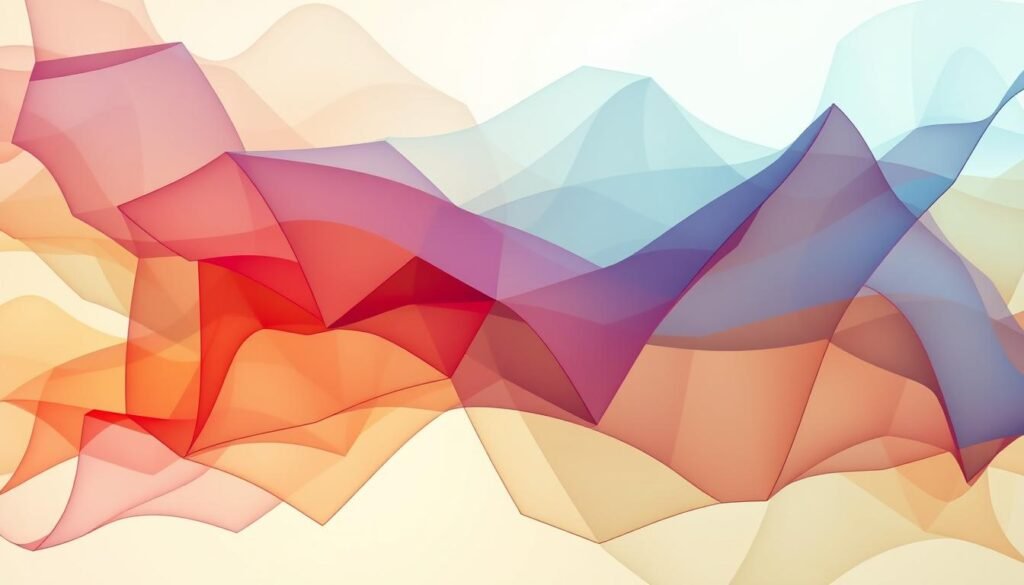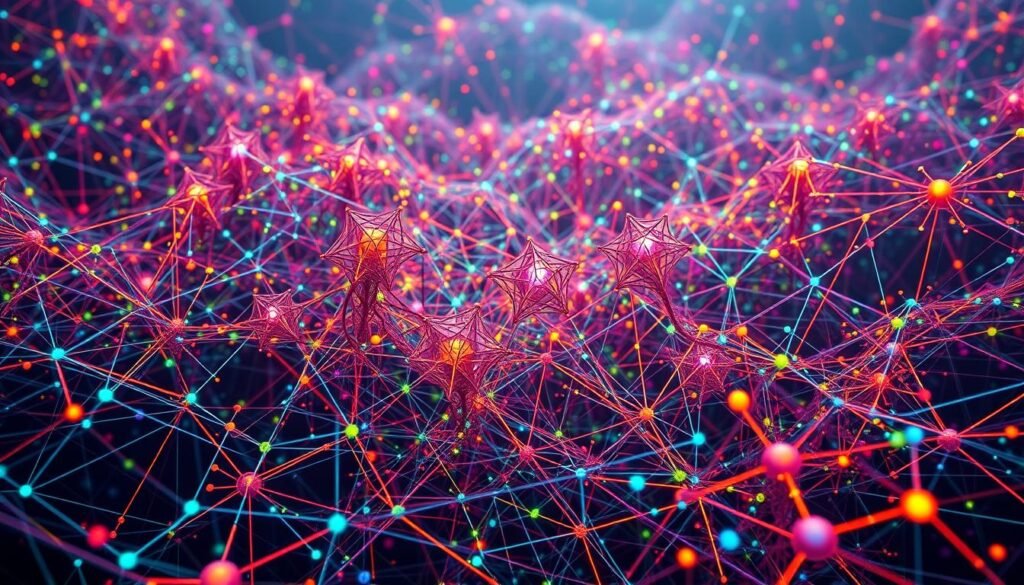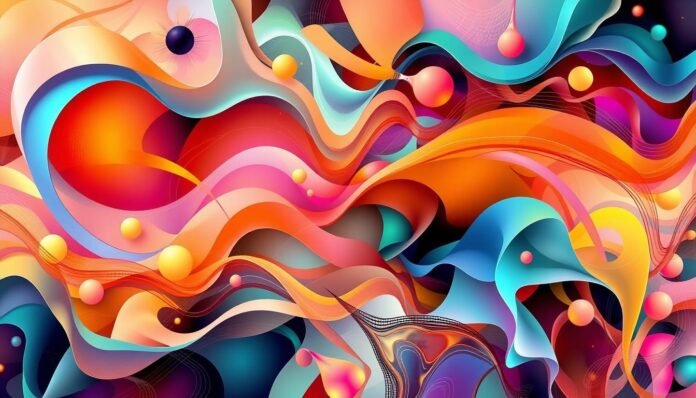In recent times, using differentiable compositing to uncover pattern structures has become popular. This method highlights the role of patterns in design and the complexity in recognizing them. It merges deep learning with graphic techniques, showing significant potential.
This blend helps in seeing patterns differently. Artists and tech experts can now better manipulate and identify patterns. Such advancements boost both creativity and the efficiency of computers.
Key Takeaways
- Discovering pattern structure through differentiable compositing is a breakthrough in graphic art.
- Patterns play a crucial role in both aesthetic appeal and computational techniques.
- Deep learning enhances traditional graphics methods for improved pattern recognition.
- Compositional pattern recognition can significantly benefit from advanced algorithms.
- Understanding patterns is essential for artists and technologists alike.
Introduction to Pattern Structure Recognition
Patterns play a huge role in graphic art. They make the art look good and organized. Knowing about patterns helps artists and designers be more creative. It helps them come up with new ideas.
The Importance of Patterns in Graphic Art
Patterns are very important in graphic art. They make the art pleasing and draw in the viewer. They can show feelings and tell stories. Artists use them to share their ideas. Digital artists use pattern recognition to improve their work. This makes their designs better.
Challenges in Manual Pattern Editing
Even with new technology, editing patterns is still hard. Artists can mess up the shapes or layout. Old ways of editing don’t always work well. This shows why we need new methods to recognize patterns. These methods help artists fix their work without losing its beauty.
The link between recognizing patterns and editing is important. New techniques help artists. They make it easier to add patterns to their art.
Understanding Differentiable Compositing
Differentiable compositing is a cool tool in computer graphics and machine learning. It helps change graphic patterns in advanced ways. By focusing on deep structures instead of just flat pictures, it can find and organize patterns. This is very useful in deep learning applications, where it’s important to keep complex patterns safe.
What is Differentiable Compositing?
Differentiable compositing blends pictures in a way that lets us measure changes based on inputs. This method helps create realistic images and explore their shapes better. It works better than older ways that can’t catch every detail of patterns.
Applications in Deep Learning and Machine Learning
This technique helps a lot in deep learning, especially in machine learning for pattern recognition. It keeps important patterns intact, letting designers and researchers create amazing visuals. For example, it’s key in making new fonts and editing pictures, changing how creatives work. See how it’s used in font generation algorithms and more.
| Technique | Description | Application Area |
|---|---|---|
| Differentiable Compositing | Blends visual elements while allowing gradients to be computed | Graphic Design, Image Processing |
| Deep Learning Models | Utilize computed gradients for training on complex datasets | Pattern Recognition, Image Analysis |
| Machine Learning Algorithms | Identify and analyze data patterns autonomously | Automation in Design, Data Analytics |
Discovering Pattern Structure Using Differentiable Compositing
The world of graphic design is always changing. It now includes ways to make patterns with new methods. Differentiable compositing is one such method. It shows us how to change patterns in smart ways. This method lets designers pull structured patterns from just looking at pictures, making edits easier.
A Novel Approach to Pattern Manipulation
Patterns have changed a lot thanks to differentiable compositing. It treats graphic parts as layers, making changes easier. Designers use these layers to tweak small details. This helps in creating more complex designs. Being able to change how an image breaks down improves flexibility. It also makes designs more adaptable with less data.
Layered Representations of Graphical Objects
Layered patterning is key in graphic design. It lets artists control their work by editing layers one by one. This means edits can be precise without losing the design’s beauty. This method simplifies making changes and leads to better results. Recent studies have shown how effective this is.

| Technique | Improvement | Time Required |
|---|---|---|
| G3DR Method | Perceptual metrics up to 22% better | Half the training time |
| 3D Head Avatar Generation | Outperforms GAN-based models | Qualitative and quantitative advantages |
| Direct Optimization for Image Decomposition | More generalizable outcomes | Less data needed |
Pattern Discovery Algorithms and Techniques
Exploring modern pattern discovery algorithms uncovers many innovative strategies. These boost graphic design and analysis. Due to better computers and methods, we can go beyond old ways of recognizing patterns.
State-of-the-Art Algorithms
The DiffFit algorithm stands out for fitting protein structures into Cryo-EM maps. It uses 3D transformations and samples densities accurately. A new loss function and volume-array strategy improve its effectiveness.
- Fitting process includes manual initial alignment followed by automated optimization.
- Evaluated on vast datasets, showcasing superior integration of composite structures.
- Time-efficient computation requires only 30 seconds, with additional 5 minutes for human interaction.
Comparative Analysis with Traditional Methods
The DiffVersify model brings advancements over old methods. It uses NMF for decoding patterns. This leads to better pattern similarity with real data. It boosts metrics like ROC-AUC, raising overall pattern discovery success.
| Algorithm | Type | Primary Use Case | Performance Metric |
|---|---|---|---|
| DiffFit | Differentiable | Fitting protein structures into Cryo-EM maps | Placement Quality |
| DiffVersify | Non-negative Matrix Factorization | Pattern decoding and similarity | ROC-AUC |
| Traditional Methods | Conventional | Basic pattern recognition | Thresholding |
Differentiable Neural Networks in Pattern Recognition
Differentiable neural networks bring a new way to recognize patterns. They change how systems see and handle patterns in many areas. Thanks to their design, these networks are great at finding patterns better. This leads to improved methods in pattern recognition.
How They Enhance Pattern Discovery
These networks can model images and complex data in a unique way. They turn patterns into simpler parts. This makes it easier to understand complex patterns. For instance, Recursive Neural Programs (RNPs) are really good at looking at parts as a whole. They can model graphic elements in layers. This helps us get a clearer picture of how patterns fit together.
Impact on Compositional Pattern Recognition
Differentiable neural networks have a big impact on recognizing complex patterns. They create a set of rules for images that they apply over and over. This makes it easier to understand complex graphics. They can tell the difference between states and actions. This helps in building and handling objects and their parts. By doing this, they make it simpler to see how graphic elements relate to each other.
Deep Learning for Pattern Analysis
Deep learning is now key in pattern analysis, especially in graphics and visual computing. It uses advanced algorithms to work with complex data. This lets us get deeper insights into images and graphics.
Utilizing Deep Learning Frameworks
Frameworks for deep learning are essential in analyzing patterns. TensorFlow and PyTorch are popular ones. They help users manage graphical data more easily.
These platforms have tools for building models that identify complex images patterns. They support different methods and make it easy for users. This is why they’re vital for creating new graphic art.
Advantages of Deep Learning in Graphics
Deep learning offers big benefits in graphics. It improves accuracy and keeps more detail than old methods. Using deep learning leads to better manipulation of images.
This changes the art world, letting artists reach new levels of precision. Deep learning mixes statistics and machine learning to better graphic creation. It makes the artistic process richer.

Challenges in Pattern Structure Recognition Techniques
Technology keeps advancing, but we still face big challenges in pattern recognition. One major issue is pixel-level manipulations when editing patterns. This approach can cause unwanted changes. It’s important to keep the core of the patterns intact to maintain their true essence.
Keeping these core structures right ensures the pattern’s integrity during edits.
Pitfalls of Pixel-Level Manipulations
Editing at the pixel level can muddle the final result. It often leads to mistakes that stray from the original design. Advanced methods like differentiable compositing are emerging as solutions. They allow precise changes while keeping the design’s key features.
Maintaining Latent Structures in Patterns
Paying attention to the core structures of patterns is key for quality recognition. Modern methods focus on preserving these elements to boost pattern clarity. With new approaches, we can better tackle pattern recognition challenges.
Innovative solutions help maintain both beauty and function of patterns. For deeper understanding, visit this source.
A Review of Differentiable Composition Methods
The field of differentiable composition methods has changed a lot since it started. We must understand the history of compositing techniques to appreciate what’s new and what’s next. At first, these methods were basic, using simple graphic rules. Over time, they got more complex thanks to machine learning and deep learning.
History and Evolution of Compositing Techniques
Compositing began with manual techniques that needed a lot of human effort. Then, as technology got better, there was a push for automated methods. This led to the creation of differentiable composition methods. These methods focused on being precise and efficient.
Machine learning changed everything, especially with deep neural networks. A breakthrough was the physics-integrated neural differentiable (PiNDiff) model. It pushed the history of compositing techniques even further, allowing us to simulate complex activities.
Future Directions for Research and Applications
The exploration doesn’t stop with what we can do now. The future is about mixing physics and advanced deep learning in new ways. This could really help in industries like aerospace and automotive, where making things strong but light is key.
We also need to overcome hurdles like not having enough data and making tests better. Doing so will make things more efficient and improve how materials perform. It’s important that future work also connects math theories with their use in the real world. By pushing forward with differentiable programming, researchers will find new ways to predict various industry needs.
For more on the latest in differentiable algorithms, check out this article.
Conclusion
Differentiable compositing has changed how we see patterns in graphics and pattern recognition. New methods like pOp and DiffFit have improved pattern making and editing. These changes show how important it is to optimize and create effective loss functions.
The future looks promising for pattern recognition. Now we can overcome old challenges with new solutions, like those in [GHYZ20]. The ability to create better patterns from different inputs is changing how we make and edit graphics.
Recent advances, seen in Volume 41, Number 4 of the Eurographics Symposium on Rendering 2022, signal growth in this area. Using DiffFit to make complex structures easily shows how far we’ve come. This progress bridges technology and art, opening new doors for creativity.
